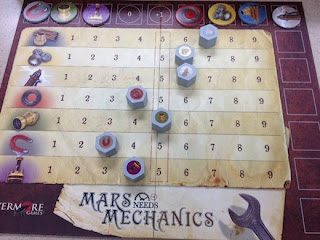When I learned that Stefan Feld and Tasty Minstrel Games teamed up, I figured that I really should try whatever they came up with. And thus, I got the privilege of trying out Rialto.
In Rialto, players vie for power in Italy - you know, by building bridges and placing councilmen and such. (Just like I do in my daily life…) The game is played over six rounds, and each round has three phases (and each phase has certain buildings that correspond to it). The first phase consists of collecting a set of six face up cards and two random cards (of which you can only keep seven). The second phase has the players play these cards at various times for different effects - gaining money and victory points, building bridges and gondolas, and placing councilmen. The final phase simply consists of activating a certain type of building. After the six rounds, players add up points based on how much control they have over each district (and how much those districts are worth) as well as which buildings they control. Whoever has the most points is declared the dictator for life over Italy! (Or the winner of the game - whichever title you think you are more likely to be able to retain.)
The first pro that I have for Rialto is that you must spend a coin to activate any of your buildings. This rule, honestly, was something that seemed very trivial (even nuisance-y) as I was reading through the rules. However, as I've played the game, I have grown in my appreciation for this. And, to give you a better understanding, this is the only use for gold coins. If you don't have buildings, then you don't ever have to worry about collecting gold! And yet, buildings can be incredibly useful. They can allow you to draw and keep more cards in the first phase. They can also allow you to change what kind of cards you have in the second phase. And they can give you direct victory points in the third phase! So, I like the fact that you must spend a gold whenever you want to use a building, because it helps the game retain a bit more balance. (And keeps it from being all about who can build the better buildings first.)
 |
| Player board for the builder in your group |
The final pro that I will mention for Rialto is that I enjoy the scoring mechanism. Each district is worth a number of points based on what bridges and gondolas connect to it. (Both bridges and gondolas are placed as a bonus for playing the most cards of certain types during the second phase, and thus their locations are determined by players.) Whoever has the most councilmen in the region gets the full number of victory points. Second place gets half as many (rounded down), third place gets half of what second earned, and so on. This means that it can be as valuable to be second (or even third) place in a district as it is to be first place in another. And so, players are encouraged to win districts, but also to be careful about which districts they win - and are also encouraged to win the bonus that allows them to place bridges, to add more value to the districts that they are already winning!
 |
| Initial card selections |
The other cons that I have are very minor, and don't really warrant much elaboration. First, there is a lot of re-shuffling the deck in the game - especially in larger games. (The deck is 77 cards, and in a 5 player game, 36 cards are out to start the round, 10 more will be drawn, and buildings can cause another 45 more (though realistically probably closer to 21) to be drawn. So, the discards will have to be collected and re-shuffled almost every round.) Second, there is quite a bit of emphasis on card counting in the game, which I'd just as soon not have to bother with - yet to not count them leaves you at a strategic disadvantage. (If you remember what your opponents selected then you can have a good idea of what they are going to play. And knowing what they can play helps you determine whether you can win bonuses.)
Overall, I enjoyed Rialto, and would give it an 8.5/10. It is a game that I could continue playing, and I appreciate that it is relatively quick to play while offering some fairly deep strategic elements.
If Rialto sounds interesting, you might also check out Notre Dame, Terra Mystica, and Belfort.
I would like to thank Tasty Minstrel Games for providing me with a review copy of Rialto.









